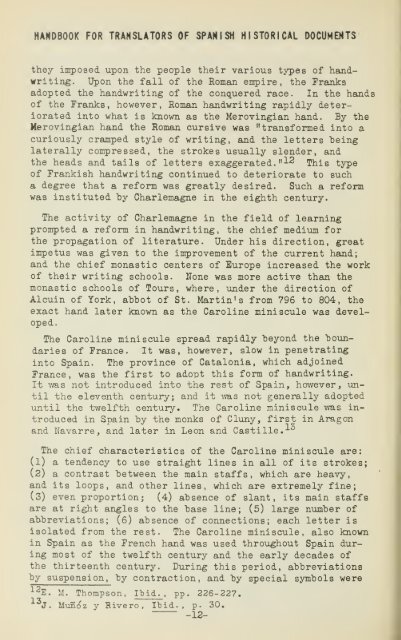Handbook for translators of Spanish historical ... - University Library
Handbook for translators of Spanish historical ... - University Library
Handbook for translators of Spanish historical ... - University Library
Create successful ePaper yourself
Turn your PDF publications into a flip-book with our unique Google optimized e-Paper software.
HANDBOOK FOR TRANSLATORS OF SPANISH HISTORICAL DOCUMENTS<br />
they imposed upon the people their various types <strong>of</strong> handwriting.<br />
Upon the fall <strong>of</strong> the Roman empire, the Franks<br />
adopted the handwriting <strong>of</strong> the conquered race. In the hands<br />
<strong>of</strong> the Franks, however, Roman handwriting rapidly deteriorated<br />
into what is known as the Merovingian hand. By the<br />
Merovingian hand the Roman cursive was "trans<strong>for</strong>med into a<br />
curiously cramped style <strong>of</strong> writing, and the letters "being<br />
laterally compressed, the strokes usToally slender, and<br />
the heads and tails <strong>of</strong> letters exaggerated. "'^ This type<br />
<strong>of</strong> Frankish handwriting continued to deteriorate to such<br />
a degree that a re<strong>for</strong>m was greatly desired. Such a re<strong>for</strong>m<br />
was instituted "by Charlemagne in the eighth century.<br />
The activity <strong>of</strong> Charlemagne in the field <strong>of</strong> learning<br />
prompted a re<strong>for</strong>m in handwriting, the chief medium <strong>for</strong><br />
the propagation <strong>of</strong> literature. Under his direction, great<br />
impetus was given to the improvement <strong>of</strong> the current hand;<br />
and the chief monastic centers <strong>of</strong> Europe increased the work<br />
<strong>of</strong> their writing schools. None was more active than the<br />
monastic schools <strong>of</strong> Tours, where, "under the direction <strong>of</strong><br />
Alcuin <strong>of</strong> York, abhot <strong>of</strong> St. Martin's from 796 to 804, the<br />
exact hand later known as the Caroline miniscule was developed.<br />
The Caroline miniscule spread rapidly "beyond the "boundaries<br />
<strong>of</strong> France. It was, however, slow in penetrating<br />
into Spain. The province <strong>of</strong> Catalonia, which adjoined<br />
France, was the first to adopt this <strong>for</strong>m <strong>of</strong> handwriting.<br />
It "was not introduced into the rest <strong>of</strong> Spain, however, until<br />
the eleventh century; and it "was not generally adopted<br />
until the "twelfth century. The Caroline miniscule "was introduced<br />
in Spain by the monks <strong>of</strong> Cluny, first in Aragon<br />
and Navarre, and later in Leon and Castille.-'-'^<br />
The chief characteristics <strong>of</strong> the Caroline miniscule are:<br />
(1) a tendency to use straight lines in all <strong>of</strong> its strokes;<br />
(2) a contrast "between the main staffs, which are hea"vy,<br />
and its loops, and other lines, which are extremely fine;<br />
(3) even proportion; (4) absence <strong>of</strong> slant, its main staffs<br />
are at right angles to the base line; (5) large number <strong>of</strong><br />
abbreviations; (6) absence <strong>of</strong> connections; each letter is<br />
isolated from the rest. The Caroline miniscule, also known<br />
in Spain as the French hand was used throughout Spain during<br />
most <strong>of</strong> the twelfth century and the early decades <strong>of</strong><br />
the thirteenth century. During this period, abbreviations<br />
by suspension, by contraction, and by special symbols were<br />
'^E. M. Thompson, Ibid. , pp. 226-227.<br />
J. M"u£oz y Rivero , I'bid. , p. 30.<br />
-12-










![Novellen [microform] - University Library](https://img.yumpu.com/21939450/1/171x260/novellen-microform-university-library.jpg?quality=85)
![Anecdota Chisiana de re metrica [microform]](https://img.yumpu.com/21939448/1/190x239/anecdota-chisiana-de-re-metrica-microform.jpg?quality=85)



![Schollenbruch [microform] : Gedichte - University Library](https://img.yumpu.com/21939437/1/174x260/schollenbruch-microform-gedichte-university-library.jpg?quality=85)

